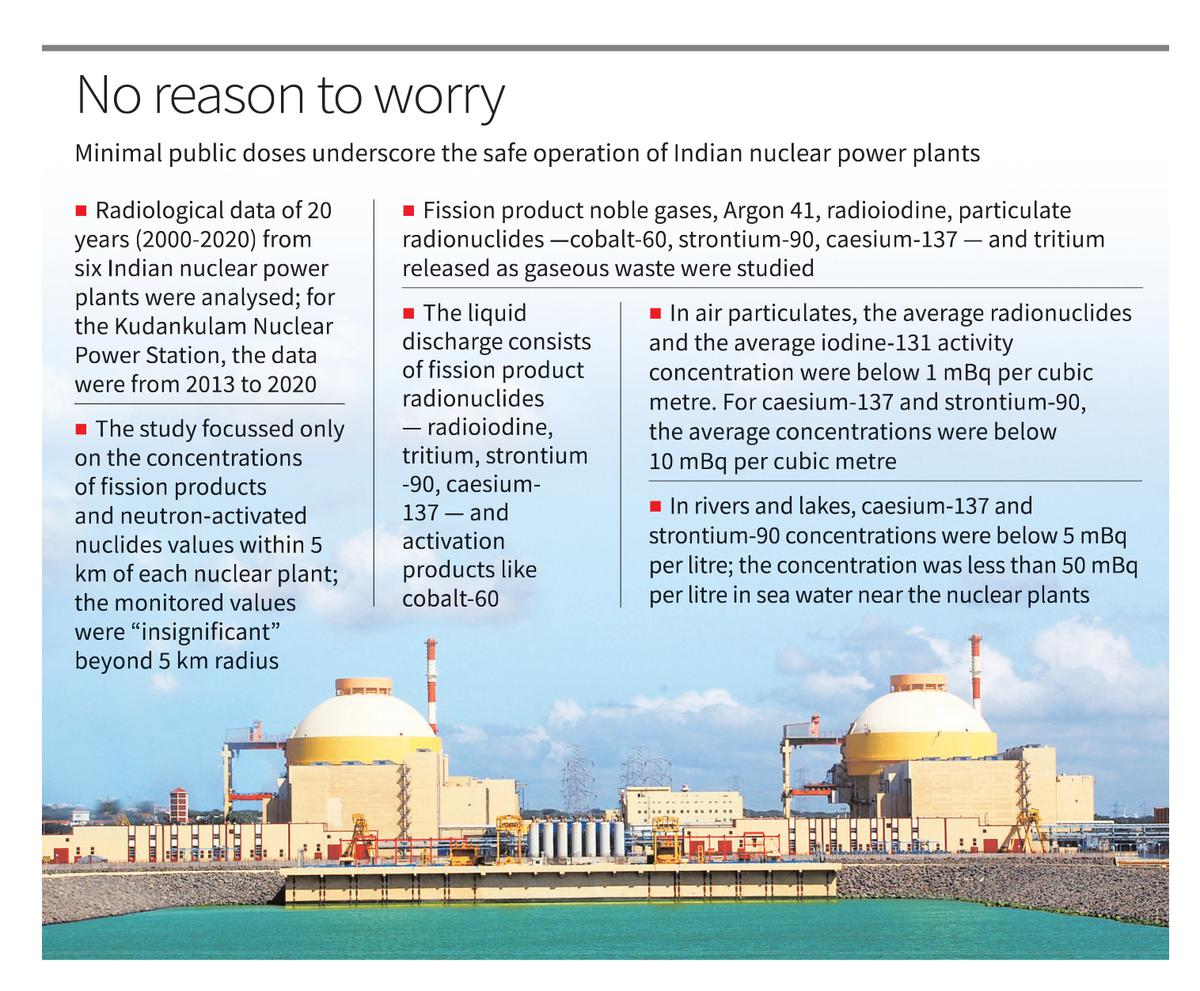Biodiversity & Environment
Radioactive Discharges from Indian Nuclear Plants
- 01 Feb 2024
- 10 min read
For Prelims: Minimal Radioactive Discharges from Indian Nuclear Plants, Bhabha Atomic Research Centre (BARC), Nuclear Fission, Implications of Radioactive Discharge.
For Mains: Minimal Radioactive Discharges from Indian Nuclear Plants, Environment Impact Assessment.
Why in News?
Recently, the researchers from Bhabha Atomic Research Centre (BARC) in an analysis has found that the Radioactive Discharges from Indian Nuclear Plants have been Minimal.
- The researchers analyzed the radiological data from six nuclear power plants in India over a period of 20 years (2000-2020).
Note
Radioactive discharge refers to the release of radioactive substances into the environment as a result of human activities, typically from nuclear facilities such as nuclear power plants, research reactors, or other industrial processes involving radioactive materials.
Bhabha Atomic Research Centre
- BARC is India’s premier nuclear research facility based in Mumbai, Maharashtra.
- It is a multi-disciplinary research center with extensive infrastructure for advanced research and development.
- Its core mandate is to sustain peaceful applications of nuclear energy, primarily for power generation.
What are the Key Findings of the Analysis?
- Minimal Environmental Impact:
- The radioactive discharges from the nuclear plants were found to have a minimal impact on the environment.
- The concentrations of fission products beyond 5 km radius have been below the minimum detectable activity of the instruments used, implying that the monitored values are “insignificant”.
- Types of Radioactive Discharges:
- Gaseous waste released into the atmosphere includes fission product noble gases, Argon 41, radioiodine, and particulate radionuclides (cobalt-60, strontium-90, caesium-137, and tritium).
- Liquid discharge consists of Fission product radionuclides, radioiodine, tritium, strontium -90, caesium-137 — and activation products like cobalt-60. .
- Radioactive discharges are carried out through dilution and dispersion, adhering to strict radiological and environmental regulatory regimes.
- Air Particulates:
- Average gross alpha activity in air particulates at all seven nuclear plants was less than 0.1 megabecquerel (mBq) per cubic meter.
- The Narora Atomic Power Station, Uttar Pradesh, exhibited higher maximum values, attributed to a higher atmospheric dust load.
- Specific Marker Concentrations:
- Average concentrations of radionuclides (iodine-131, caesium-137, and strontium-90) in air particulates across all sites were below 1 mBq per cubic meter.
- Concentrations of caesium-137 and strontium-90 in rivers, lakes, and sea water near the nuclear plants were below specified levels.
- Sediment Concentrations:
- The concentrations of caesium-137 and strontium-90 in sediments were within the statistical variation of values observed in natural sediments, without showing any trend of deposition or accumulation.
- Tritium Detection:
- Tritium was detectable above the minimum detectable activity at all sites except the Kudankulam Nuclear Power Station.
- Tritium concentrations were relatively higher at the Rajasthan Atomic Power Station.
What is the Significance of the Findings?
- The findings hold potential significance for reinforcing India’s commitment to advancing its nuclear power programme. The minimal public doses underscore the safe operation of Indian nuclear power plants.
What are the Implications of Radioactive Discharge?
- Environmental Impact:
- Radioactive substances released into the environment can impact ecosystems, affecting plants, animals, and microorganisms.
- Radioactive particles can settle on soil and sediment, leading to contamination. In water bodies, radioactive substances may accumulate, potentially affecting aquatic life.
- In 1986, the Chernobyl Disaster released a significant amount of radioactive particles into the atmosphere. These particles settled on soil and water bodies, leading to widespread contamination. The nearby Pripyat River and its tributaries were affected, impacting aquatic life.
- Human Health Concerns:
- Radioactive discharges can expose nearby populations to ionizing radiation. Prolonged or high-level exposure may increase the risk of radiation-related health issues, including cancer.
- People may inhale or ingest radioactive particles, especially through contaminated air, water, or food. This can lead to internal radiation exposure.
- In the Chernobyl disaster, the exposed population, including workers and nearby residents, experienced increased rates of thyroid cancer due to the release of iodine-131.
- Long-term Health Risks:
- Exposure to certain radioactive substances, such as strontium-90 and caesium-137, is associated with an increased risk of cancer, particularly if the exposure is prolonged.
- Ionizing radiation can potentially cause genetic mutations, increasing the risk of hereditary disorders in future generations.
- Impact on Agriculture and Food Chain:
- If radioactive substances enter the food chain, agricultural products and livestock may become contaminated, posing risks to consumers.
- In the 2011 Fukushima Nuclear Disaster, nuclear radiation contaminated agricultural products, such as rice and fish, raising concerns about food safety.
- Economic Consequences:
- Areas near nuclear facilities that experience radioactive discharges may see a decline in property values due to concerns about safety.
- Repeated incidents of radioactive discharge can harm the reputation of the nuclear industry, potentially affecting investment and development of new projects.
- Three Mile Island Accident (1979) contributed to a decline in public confidence in nuclear power, leading to increased regulatory scrutiny and a slowdown in the development of new nuclear projects in the United States.
What are the Initiatives Related to Safe Radioactive Discharge?
- International Conventions & Agreements:
- Convention on Early Notification of a Nuclear Accident: It is a treaty adopted in 1986 by the International Atomic Energy Agency (IAEA).
- The treaty requires countries to provide prompt notification of any nuclear accident that may affect other countries.
- Joint Convention on the Safety of Spent Fuel Management and on the Safety of Radioactive Waste Management: It is a 1997 treaty from the IAEA. It was the first treaty to address radioactive waste management on a global scale.
- It aims to address the safety of spent fuel management and radioactive waste management, including the prevention of accidents and minimizing potential radiological hazards.
- Convention on Nuclear Safety (CNS): The CNS is a legally-binding treaty that was adopted in 1994 and aims to ensure the safety of nuclear power plants. The CNS is an incentive-based treaty that requires states to establish and maintain a regulatory framework for nuclear safety. The CNS also aims to protect people, society, and the environment from the harmful effects of ionizing radiation.
- European Union (EU) Directives on Radioactive Waste and Spent Fuel Management: The European Union's (EU) Radioactive Waste and Spent Fuel Management Directive requires EU countries to have a national policy for managing radioactive waste and spent fuel.
- The directive also requires countries to create and implement national programs for managing these materials.
- Convention on Early Notification of a Nuclear Accident: It is a treaty adopted in 1986 by the International Atomic Energy Agency (IAEA).
- India’s Initiatives:
- Atomic Energy Regulatory Board (AERB): AERB serves as the regulatory body for nuclear and radiation safety in India. It establishes and enforces regulations, guidelines, and standards to ensure the safe operation of nuclear facilities, including measures for radioactive discharge.
- Environmental Impact Assessment (EIA): Nuclear projects, including power plants, are subject to rigorous environmental impact assessments. These assessments evaluate potential environmental and health impacts, including radioactive discharges, before a project is approved.
- Effluent Treatment and Dilution: Nuclear facilities employ effluent treatment systems to manage liquid radioactive waste before discharge. Dilution and dispersion techniques are often used to minimize the concentration of radioactive substances in discharges.
Previous Year Question (PYQ)
Q. To meet its rapidly growing energy demand, some opine that India should pursue research and development on thorium as the future fuel of nuclear energy. In this text, what advantage does thorium hold over uranium? (2012)
- Thorium is far more abundant in nature than uranium.
- On the basis of per unit mass of mined mineral, thorium can generate more energy compared to natural uranium.
- Thorium produces less harmful waste compared to uranium.
Which of the statements given above is/are correct?
(a) 1 only
(b) 2 and 3 only
(c) 1 and 3 only
(d) 1, 2 and 3
Ans: (d)
Q. Which among the following has the world’s largest reserves of Uranium? (2009)
(a) Australia
(b) Canada
(c) Russian Federation
(d) USA
Ans: (a)








